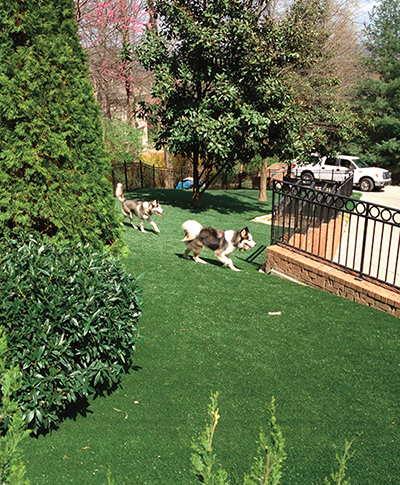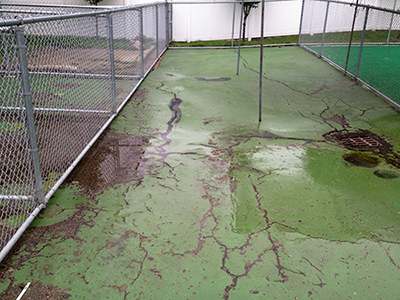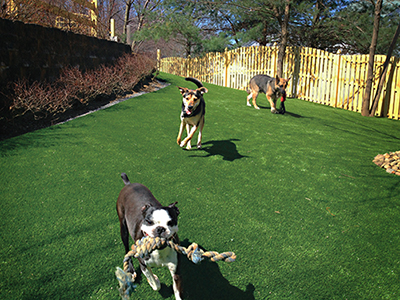
How Safe is Your Surface?
Environmental and Safety Considerations
of Pet Facility Surfacing
By Ken Karmie
The public has demanded better and more interactive care for their pets/dogs, and the industry has responded. While “basic needs” providers do exist, it is now the norm for customers to expect much more. Dogs don’t typically live at home in isolation on cold concrete or gravel floors, and owners don’t expect that kind of care from a quality pet care facility.
Pet care facilities have shifted their aim from merely shelter and food to amenities reminiscent of hotels or resorts and interaction more similar to childcare offerings. Sterile kennels made of concrete and steel have been replaced by pet resorts and doggie daycares. Dogs are gathered together in safe, comfortable, and inviting environments for playing, socializing, and interacting.
Over the past eight years, artificial grass has become an integral part of this offering. It provides a surfacing solution that meets and exceeds the desires of both the dog and dog owners. It is beautiful, gives dogs a softer grass-like surface to play on, and provides facility owners a consistent, lower-maintenance alternative that attracts clients.
Beyond the visible benefits of artificial grass lie questions on health, safety, and environmental considerations. Facility owners, customers, neighbors, and community officials want to know if artificial grass is safe for the dogs as well as the people who share the local environments. In most cases, regulations and guidelines written for the sterile boarding pens of years ago leave officials lacking information on how to address the needs and desires of this new breed of pet resorts and daycare facilities. Before we dive into the specifics on artificial grass. Let’s consider the options facility owners have for designing today’s pet facilities and the corresponding environmental and safety considerations.

Natural Grass
It looks good, feels good, and dogs love it. This pervious surface allows for wastewater to be passed into the ground for natural filtration by the soil. Unfortunately, in addition to the unsanitary issues (and there are many), it is challenging and just not practical with any real volume of dogs to maintain natural grass in commercial dog facilities.
The upkeep of natural grass often includes pesticides and fertilizers, which may be harmful to pets and local water supplies. Even with these chemicals, natural grass dies off quickly in high traffic facilities and becomes unsightly. This increases the dust and mud in the area and leaves dogs and facilities dirty and unpleasant.
Routine maintenance like grass mowing releases emissions into the air while spreading hard-to-find fecal material around. This is often the source of increased unpleasant odors and raises the risk of the spreading disease. Additionally, this creates challenges inside a facility as dog paws and fur carry unwanted waste inside with them. Maintenance costs and health-associated risks increase while staff morale and customer satisfaction decrease.
Additionally, digging dogs leave holes and hazards, leaving it unsafe and unsightly. Unfortunately for high-volume facilities without multiple acres and a dedicated maintenance staff, natural grass just isn’t a workable solution.
Loose Fill: Mulch or Gravel
While not as soft and inviting as grass, gravel and mulch come in many shapes, sizes, and colors. Because of the ease of design and installation, this loose fill surfacing is gaining popularity. These surfaces don’t die like natural grass and usually have a lower initial cost, although maintenance and replacement greatly increase this investment over time.
As with natural grass, these surfaces are pervious, allowing wastewater to pass through and natural elements to mitigate the organic waste. But this process takes time, and with the quantity of waste matter in a pet facility, a thorough maintenance plan, including enzymes and disinfectants, is required to prevent an unsanitary yard.
Loose fill surfaces have many negative characteristics that affect their use in pet facilities. The appearance is not as appealing as grass and often looks disheveled. The material is easily displaced by running dogs and tracked around and into the facility. This displacement and shifting can also lead to tripping hazards for people and is harder on dogs’ joints and paws.
Mulch and gravel surfaces are hard to maintain and keep clean due to their lack of consistency. Waste easily gets mixed up in the material and lost prior to staff removing it. This can build up over time, causing odor and unhealthy conditions. These surfaces also often need to be replaced or regularly replenished, as they tend to wash away and settle. This is an ongoing expense that is frequently overlooked in initial cost analysis.

Hard Surfaces: Concrete and Asphalt
Hard surfaces are generally flat and somewhat smooth, providing a solid, consistent, durable surface for the dogs and facility owners. Hard surfaces also make it easier for staff to locate solid and liquid waste for clean up.
While hard surfaces are typically considered impervious, concrete and asphalt will allow wastewater to penetrate unless specially treated or coated with the appropriate materials. There is also the misconception that because of their hard, solid, flat nature, they are easier to keep clean and are therefore safer for dogs. If that were true, it may be worth sacrifice in comfort and appearance, but the facts just do not support this.
Concrete and asphalt are very hard on dogs’ paws and joints. While there may be some kennel areas where hard surfaces are acceptable, play areas certainly need to offer dogs a more forgiving and natural surface. Also urine and wastewater on concrete spread, puddle, and run, causing increased exposure to the dogs. Contrary to the immediate pass through of liquids on pervious surfaces, this liquid waste remains completely available to dogs until staff can physically remove it.
Finally, concrete and asphalt surfaces are not only unnatural to dogs, but they can also lead to confusion in the dog’s behavior when they are sent home. While it becomes acceptable (even mandatory) for dogs to eliminate waste on these surfaces while boarded, it is typically not acceptable behavior at home.
Some have claimed that these hard surfaces offer environmental benefits, but a closer look shows the opposite may be more accurate. The EPA and LEED building guidelines are striving to reduce the amount of storm water runoff and, therefore, are limiting the use of impervious building materials. Utilizing hard surfaces for a dog boarding or play area will add even more undesirable impervious surface and runoff to a development.
Most communities will not allow wastewater runoff into their storm water drains. Some municipalities suggest sloping these hard surfaces to capture and direct the wastewater to sanitary sewers. The reality is that this is not only unnecessary, but it is impractical due to the typical size of the area and the fact that any precipitation must now feed into and be processed by the sanitary sewer. The unintended consequences are only compounded when the inevitable suggestion arises that a roof can then be constructed to prevent precipitation getting into the area. The complexities and expenses related to an approach like this are not practical or desirable and are far beyond any perceived benefit.

Compared to solid surfaces like concrete, artificial grass is easier on dogs’ paws and joints and offers a great place for dogs to run and play.
Artificial Grass
Artificial grass provides a unique solution to the pet surfacing challenges. All artificial grasses are not the same, but some products are specifically engineered with dogs in mind. When considering this option, do your research and be sure that the product and company you choose is pet focused. These specifically engineered artificial grass surfaces provide a great combination of the best benefits of natural grass and hard surfaces.
Like natural grass, pet-designed artificial grass looks good, feels good, and dogs love it. It is easy on their paws and joints and offers a great place for dogs to run and play. Also like natural grass, it is pervious and permits wastewater to immediately evacuate through the surface and filter through the gravel base. Naturally occurring bacteria and organisms in the soil mitigate any remaining waste and impurities.
Like the hard surfaces, artificial grass provides a surface where solid waste is easy to locate and remove, and a regimen utilizing disinfectants and cleaning products can be used to treat the surface. It is important that you find the products that are right for you and your routine. While some disinfectants need extended exposure to be effective, others offer “instant kill” disinfecting. There are also foaming products available if the time of exposure and irregular surface are of concern.
Below the surface, only liquid waste and slight remains of residual solid waste are washed through into the base. This water is rinsed through the gravel and into the soil with regular rinsing and cleaning cycles. As with other pervious surfaces, treatments with naturally occurring bioactive enzymes can be added to ensure waste is properly broken down. Enzyme products work by adding naturally occurring bacterial spores that produce “odor-eating enzymes” to reduce organic waste (feces and urine). The bacterial spores, which are similar to probiotics, live to process this waste. When the food supply is gone, they become dormant, leaving behind an odor-free solution of CO2 and water. These products can be utilized to treat any organic debris buildup in the base or soil typically due to the lack of rain flushing the base. They can also reactivate in the future if water and organic matter again come in contact with them.
It is important to note that artificial grass is made of plastic products. There is nothing in plastic that is desirable for germs and microbes. Even so, you can provide an even cleaner, safer environment by purchasing a product with a built-in antimicrobial agent. When you do, you have a “microbe mitigator” always present and working. These additives will not reach out and kill all microbes, but when there is direct contact, the microbes are eliminated. Direct sunlight in conjunction with the radiance of plastic products is also effective at eliminating microbes.
The pet care industry has changed, and the surfacing demands have changed with it. Today’s pet facilities need to provide not only a place to sleep but also a place for pets to socialize and play: a home away from home. Properly installing the right artificial grass will enable you to meet these high demands while allowing you to find the right balance between “safe for the dogs” and “safe for the environment.” Simply said, it can help you put the “care” in “pet care facilities.”
Ken Karmie is the K9Grass Brand Manager and part owner of ForeverLawn Incorporated the makers of K9Grass, artificial grass designed specifically for dogs. In addition to his experience with K9Grass, he also has extensive knowledge and experience with artificial grass for sport fields, playgrounds, landscape, rooftops, golf greens and other specific markets. Ken received a Bachelor of Science Degree from Mount Union College and spent 20 years working in the technology field before joining brothers Dale, Brian and Jim at ForeverLawn Inc. Ken designs artificial grass and related products, installation systems, maintenance programs and has worked in the synthetic grass field for over 9 years. Ken currently has two patents pending related to Indoor K9Grass design and Flushing System. Ken has also been invited to speak at various conferences and seminars regarding aspects of artificial grass use with dogs.


